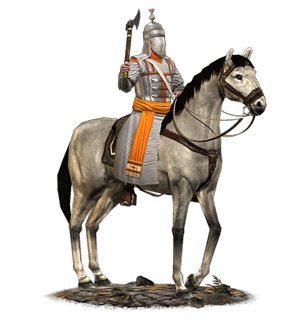Difference between revisions of "Rajput Zamindar (ETW Unit)"
(Created page with "These heavy cavalry are armoured from head to toe in mail and plate, giving them a terrific shock value as they charge home. {{Unit|image=Image:Rajput_zamindar.jpg| Class= E...") |
(→Factions) |
||
| Line 24: | Line 24: | ||
==Factions== | ==Factions== | ||
| − | *[[Image:Ottoman_flag.jpg|25px]] [[ | + | *[[Image:Ottoman_flag.jpg|25px]] [[Ottoman Empire (ETW Faction) | Ottoman Empire]] |
[[Category:Heavy Cavalry]] | [[Category:Heavy Cavalry]] | ||
Revision as of 09:14, 9 January 2011
These heavy cavalry are armoured from head to toe in mail and plate, giving them a terrific shock value as they charge home.
Overview
An elite force, the zamindars are not particularly swift, but they are intimidating. Any foe that gets into close combat with them may suffer a severe mauling, and they can simply ride right over lighter cavalry, disorganised troops or infantry that has not formed square. They are, however, vulnerable to artillery bombardment and disciplined musketry; it would be wasteful indeed to commit them against infantry in square.
The zamindars were originally a class of almost-feudal tax farmers: men empowered to collect taxes from the peasantry. From being tax farmers, the zamindars slowly accumulated all the responsibilities and power of lesser aristocracy or gentry. The title itself is a Persian borrowing, and means "landholder". The zamindars kept their holdings as long as taxes were forthcoming. Over the years, they became actual landowners, and gradually assumed military responsibilities as well. Some of these could be deferred by sending money, but it was also expected that these gentlemen should fight as irregulars for their overlords. The zamindar tax system survived even in areas ruled by Europeans; there was a β€?change of managementβ€? and a change to where the tax revenues were sent, but that was all.
